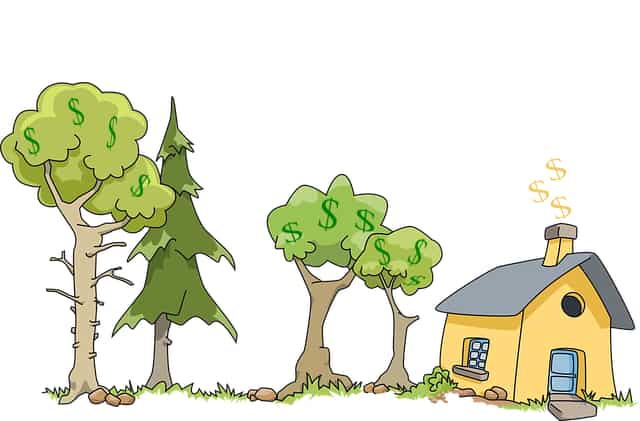Where to Stash Your Down Payment Savings
Last Updated on May 11, 2023 by Carolyn

Note: This post may contain affiliate links. Full disclosure here. Investment advice published here is of a general nature only as disclosed here.
Where to Stash your Down Payment Savings
Note: This post has been updated to reflect the current economy in 2023.
Where should you stash your down payment savings? That’s a very good question. You want to see it grow not to stagnate in a bank account earning a dismal interest rate of less than 1%. But on the other hand, you can’t afford to lose the stash you’ve so steadfastly saved. Is investing in stocks too risky? If all your eggs are in this one basket your dreams of homeownership could plummet right along with the market, should it crash.
So what should you do? It seems that real estate prices are rising by the day but your down payment stashes rate of return isn’t keeping up and the gap between your required down payment and your nest egg keeps growing despite your diligent saving.
My daughter is 21 and is saving for her first house. I’ve cautioned her to wait out this housing boom and buy when prices realign with reality. In the meantime, she wants to earn a better return on her home down payment savings.
“Can you invest my money for me”, she asks. I respond “No, but I’ll help you decide where to invest it.” I’m a firm believer in learning by doing, and if I guide her on where to start, she’ll learn by implementing the plan.
Establish Your Timeline
Table of Contents

I ask “When would you like to buy your first home?” She replies “In the next couple of years”. Looking at your timeline is important when implementing any investment strategy. She adds, “Hopefully by then the housing market will have cooled down, if not I might wait a little longer.”
Many people are afraid that if they don’t buy right now that they’ll miss their opportunity and never be able to. I don’t agree with this philosophy. There are some markets where it just doesn’t make sense to buy. When your rent is less than what your mortgage payment would be with insurance and property taxes factored in, you’re probably better off not buying. What about all that possible appreciation you won’t earn because you’re renting, isn’t that a missed opportunity? Perhaps, but if you take the monthly payment savings as well as the additional costs you’d incur as a homeowner for maintenance, property taxes, and insurance, and invest that, the opportunity cost is not as large as you’d think.
Diversification: Maximize Returns While Minimizing Risk

This is my original recommendation from 2021:
I tell my daughter “I recommend you diversify your investments to maximize possible upside appreciation and minimize investment risk.” I go on to recommend my daughter invest in the following 4 different types of investments:
- I-bonds;
- A non-publicly traded REIT such as Fundrise;
- High Yield Savings account with Bonus;
- Index Fund such as Vanguard VTSAX or PRILX for a more sustainable option
Updated recommendation 2023:
Since the current rate on I-Bonds has dropped to 4.3% I wouldn’t add additional I-Bonds to my portfolio but would suggest purchasing Cd’s instead. Current rates of return on CD’s are in the 5% range for a 6 month term.
I-bonds
I-Bonds: You might be wondering what is an I-bond? An I-bond is a security that earns interest based on both a fixed rate and a rate that is set 2 times a year based on inflation.
The current rate of I-bonds for the term May 01, 2023 to October 31, 2023 is 4.3% drastically down from the previous rate of 9.62%.
The maximum annual purchase is $10,000 in electronic bonds and up to $5,000 in paper bonds purchased with your income tax refund.
I- bonds can be purchased from Treasury Direct.
Non Publicly Traded REITS
Non-Publicly traded REITs are a means to keep a foot in the real estate market. Many, like Fundrise have pretty stellar earnings records. At the time of writing this post, Fundrise funds have consistently yielded returns from 8%-11% annually, with the exception of 2022 which had a dismal return of 1.5% (which compared with the S&P 500 negative return of -18.11% still didn’t look that bad). They also boast only 1 quarter with negative returns, so to date have proven to be much less volatile than the stock market. With minimum purchases as low as $10, these funds are a nice way to get your foot in the real estate investing door.
Non-Publicly Traded REITS are real estate investments with company shares that are not listed on a public exchange. They allow investors to invest in investments that include office space, multifamily properties, residential developments, farmland, shopping centers, hotels, warehouses, etc. REITs allow investors to diversify their real estate portfolios while benefiting from the experience of seasoned managers.
Another real estate investment platform I’m investing with is Groundfloor. Groundfloor loans funds to individual projects and then sells portions of these loans to investors who receive interest on the money they lend to the project. I have earned a 9.4% annualized return in my first year of investing with Groundfloor. You can invest as little as $10.00 with no fees for investing.
High Yield Savings Accounts with Bonuses
Due to rising interest rates, High-yield savings accounts (HYSA) have become worthy of consideration again. Rates are in the 4% range with 4.85% at CIT with a minimum balance of $5,000 being a frontrunner at the time of writing.
HYSA returns can also be significantly boosted by choosing accounts that offer opening bonuses. These bonuses vary based on the average amount invested, minimum investment period and often require monthly direct deposits. Account opening bonuses are normally in the $150-$300 range.
Nerdwallet.com keeps a good list of account bonuses available with a description of terms and conditions.
Index Fund
You might be surprised that I recommend that my daughter put a portion of her hard-earned money into an index fund. What if the market crashes?
I counter that question with ” What if the market doesn’t crash? ” She’d have missed out on a lot of potential growth. There are ways to protect your stock investments with stop-loss strategies that will allow you to reap the rewards of an increasing market but minimize downside risk.
I choose an index fund like VTSAX for her because this fund spreads its investments over the entire stock market, thus reducing overall risk, it has low fees and is operated by Vanguard, a leader in the low-cost index fund sector. Over the past 10 years, this fund has yielded over 11.27% return.
A more sustainable option would be PRILX which has yielded 11.92% over the past 10 years (proving that investing sustainably doesn’t sacrifice returns)
Be Pro-Active
Don’t be thinking you can invest your savings, kick up your heels and just watch it grow. You need to be sure to invest the additional funds you put aside each month, and make them work for you! Since I published this post I have revised my recommendations, and you too should take the time to review your holdings to maximize return.
You should also rebalance your investment portfolio from time to time. Though it may be tempting to put all of your money in the investment that’s doing best, that violates the whole concept of diversification. Be sure to keep the investments in the different sectors fairly equal.
Follow the Growth of My Daughters Down Payment Stash
I’ll posting updates on the progress of my daughter’s nest egg. This month she’ll be implementing her savings strategy which will be to invest fairly equally in the investments described above.
If you have a 22 year old daughter you probably know how hard it is to nail them down and get numbers from them-but I’ll try to do that shortly and post an update to how her investments have fared!







8 Comments
June
Great post! I’m currently saving for my next house and have my funds in a high yield savings account. I’d never heard of the other options! I’ll have to check them out.
Carolyn
Please do take a look at them, they can really help your nest egg grow.
Martina
This is honestly very helpful and insightful! I absolutely love the Be Proactive part. Most of the time I forget that it takes patience to watch your investment grow. Thank you for sharing this with us! xx
Carolyn
Thanks for the nice comment. It’s easy to forget to be proactive. I can’t believe the difference it’s made in my investment returns.
Reut shaviro
Nice post 🙂
Barbara Bailey
Great article very helpful…
Kali Todd
Great post! I utilized my Roth IRA earnings for the downpayment on my first home which I purchased during the craziness of COVID. It’s fantastic that the Roth IRA stipulates that $10,000 can be withdrawn both tax free and penalty free for a first time home buyer. The stock market was sky high and I had returns of over 30%. This along with my high-yield savings account allowed me to get to my goal of purchasing a home so much quicker! Good luck to your daughter!
Carolyn
That’s awesome that you were able to take advantage of this tax break. I hope my daughter can too!